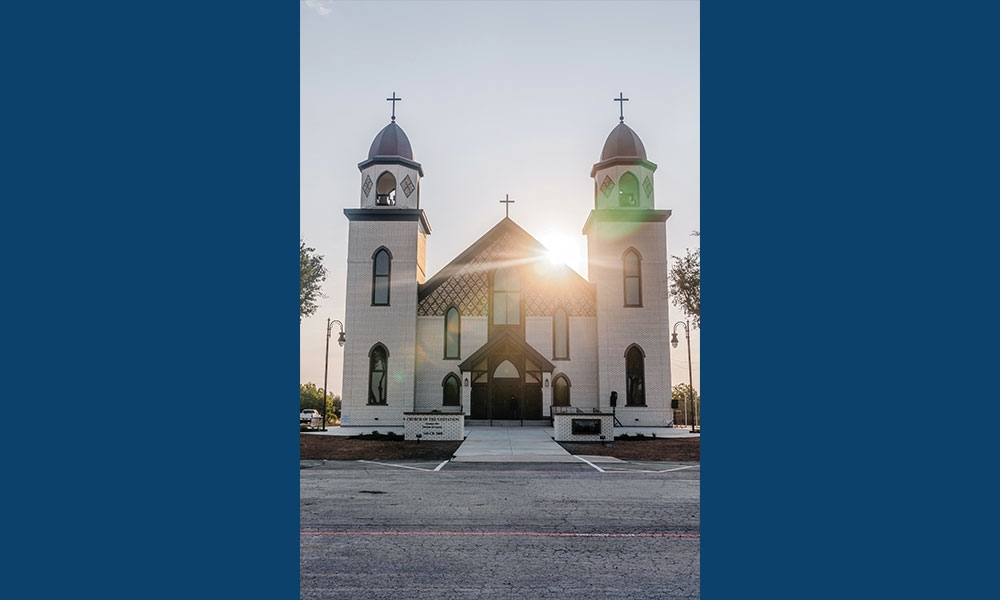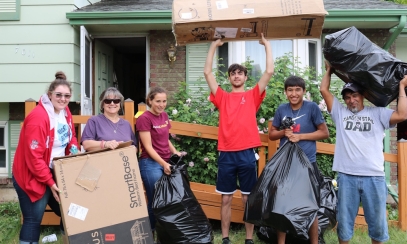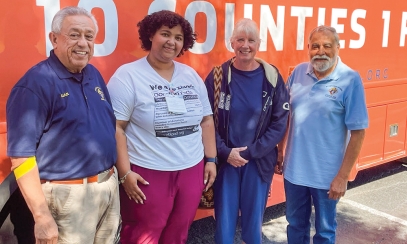
Twin steeples rise from the ashes in Westphalia
The Church of the Visitation, completely rebuilt after the tragic fire that destroyed it in 2019, was consecrated by Bishop Joe Vásquez on Aug. 27.
The Church of the Visitation, completely rebuilt after the tragic fire that destroyed it in 2019, was consecrated by Bishop Joe Vásquez on Aug. 27.
“This is truly a glorious day. It is indeed a beautiful church, dignified and truly worthy of being called a house of prayer,” Bishop Vásquez said to the faithful packed into the new sanctuary, as well as to those joining the celebration via livestream.
The new church is the fourth structure built by this largely German-heritage parish founded in 1883. Storms heavily damaged the first two churches, in 1885 and again in 1893. The devastating fire of 2019 leveled the historic wooden church with its dual bell towers that had stood on the Westphalia hilltop since 1895.
Father Darrell Kostiha, pastor of Visitation Parish and a native son of Westphalia, said the rebuilding process has reminded him and the community of how Christ makes all things new.
“We are reminded how the redeeming grace of Christ flows from the cross to offer us the sublime gift of new life, individually and communally,” he said. Behold, I make all things new (Rev 21:5), he said in Latin.
Builder Keith Helpert of K4 Construction from Robinson, which rebuilt the historic Westphalia church, said the new front doors are made from charred support timbers recovered after the fire.
“Stanton Studios of Waco cut off the burnt part and planed down the long-leaf yellow pine. It was the only thing we could reuse,” Helpert said.
As worshipers approach the west-facing doors, they first touch these structural remnants of the old church as they enter the new one — a symbolic recollection of the venerable wooden church lost to fire and a reminder that new life always supplants the old.
Members of the parish’s rebuilding committee envisioned a new church patterned closely off the previous one. Architect Julie Ellison with K4 Construction said, “We were charged with reconstructing the church as it once was — cruciform shape, dual towers, and domed sanctuary — in a such a way to recall the feel of the original church, to bring back to life that similar look but in completely different and longer lasting material.”
The new Church of the Visitation is slightly bigger and constructed with a brick veneer designed to mimic the painted façade of the old church. The new church features a layout more conducive to contemporary worship — the side aisles are now against the wall, allowing for unobstructed sight lines of the sanctuary as well as access to walk directly beneath the Stations of the Cross.
The new church features the baptismal font at the entrance of the sanctuary. Baptism is the sacrament of initiation, the gateway to membership and full participation in the Catholic faith. Building Committee member Mark Bartek, whose great grandparents lived in Westphalia, reflected on the change, “You have to break away a little from what you grew up with to understand the significance of the baptismal font at the entrance, because baptism is the beginning of our faith journey.”
Long-time parishioner Geraldine Kahlig, said the new stained glass windows are re-creations of the ones lost in the fire, which had come from Germany.
“Foster Stained Glass in Bryan refurbished the windows a few years ago,” she said, “so we turned to them because they had all the drawings.” The crowning piece is a dramatic pentagonal window above the altar illustrating the visitation of Mary to Elizabeth (Lk 1: 39-56), the scriptural scene that is the church’s namesake.
The Church of the Visitation is the centerpiece of a devout Catholic community, located about 13 miles east of Temple. German farmers and ranchers moved to the area in 1879 and subsequently built the first church, the Little School, and the cemetery. Later, a rectory, religious education center, new school (which became the Westphalia Independent School District in 1935), and parish hall were added. Bishop Vásquez admired how this tight-knit community sticks together through good times and bad.
“Even when the church [building] burned, your community, your church, continued to exist,” he said.
Retired Deacon Bill Smetana said the Westphalia parish holds many memories.
“All my life was in the old church, so that’ll always be in my heart,” he said, “I was baptized there, went to school there, took first Communion there, got confirmed there, got married there, so it’s kind of like home. But it’s wonderful to be back in a new church.”
Now the church steeples can again be seen across the pastures and fields of Falls County. The same faith that sustained the community almost 150 years ago still pulses today. The parishioners of Westphalia know that it is not really a building that they have rebuilt but rather a symbol of God’s kingdom dominating this picturesque rural landscape.
As Kahlig observed, “God will continue to be the center of the Westphalia community.”
Louis A. Gamino is a clinical psychologist at Baylor Scott White Health and a member of St. Luke Parish in Temple. Find more about him at www.LouisGamino.com.



